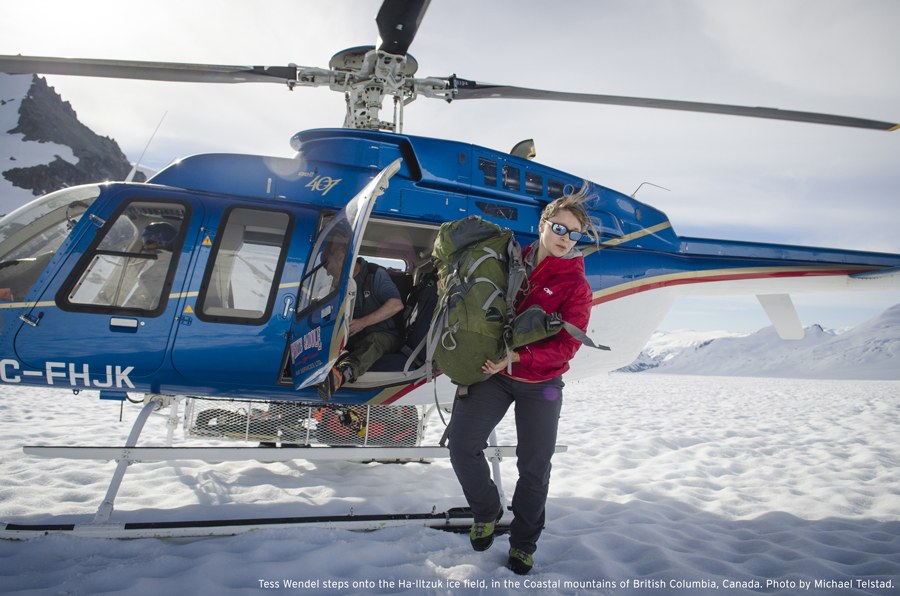
by Suzanne Gerber, Mountaineers Creative Manager
Every explorer needs a few essentials to survive. Some might even say ten. But what does a person do when one of their essentials breaks? Say… their compass stops pointing north? They’re still on their journey and need it to survive. The answer: the best they can with the tools they have. This is the essence of resilience.
Tess Wendel was 24-years old when she was diagnosed with acoustic neuroma. It’s a brain tumor that grows in the space surrounding the hearing and balance nerve. Tess was a dancer, a backpacker, and had just started her job at The Mountaineers, excited to get into climbing. Prior to that, she was a park ranger in the North Cascades. A brain tumor — especially one that affects balance — could devastate her active lifestyle.
In October 2012, Tess had part of her skull removed in a surgery that extracted the tumor and most of her balance nerve on the left side of her head. A question mark-shaped incision was cut around her ear and a half-dollar-sized piece of skull was taken out to perform the operation. Once the tumor was removed, a biodegradable plate was placed where the bone had been with muscle from her neck padded on top, and she was stapled back up. After three days in intensive care and a fourth at the orthopedic clinic, she was good to go.
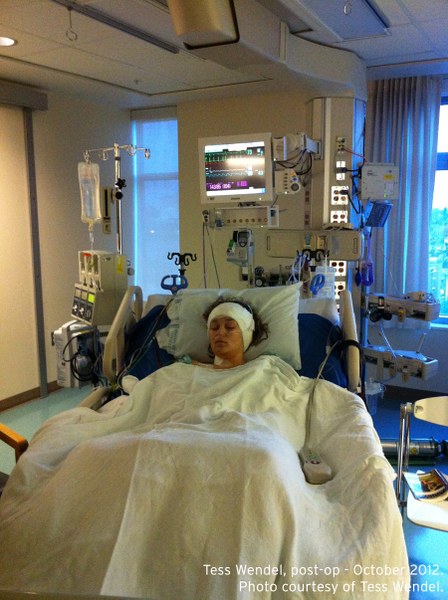
Except when she woke up. Half of her face was paralyzed and she had complete hearing loss in her left ear. A lot of rehabilitation was needed. Fortunately for Tess, the anatomy of humans is mostly symmetric and we have two balance nerves — one on each side of our heads. However, walking around with only one, after having been born and raised with two, takes some getting used to. Tess literally had to learn to walk again. Going up stairs was particularly challenging. She had headaches all the time and she said, “getting into a car felt like getting into spaceship and going 600 mph.”
Recovery
At 24, it’s hard for friends to fully grasp the time needed to recover from brain surgery — especially if you’ve promised to help start a dance company. Tess, along with her friends Gabrielle Gainor, Austin Sexton, and Jasmine Morgan founded Relay Dance Collective in winter of 2012. They had their first performance in the summer of 2013. They’ve had two series of shows each year since and are now onto their sixth season, performing at YAW Theatre.
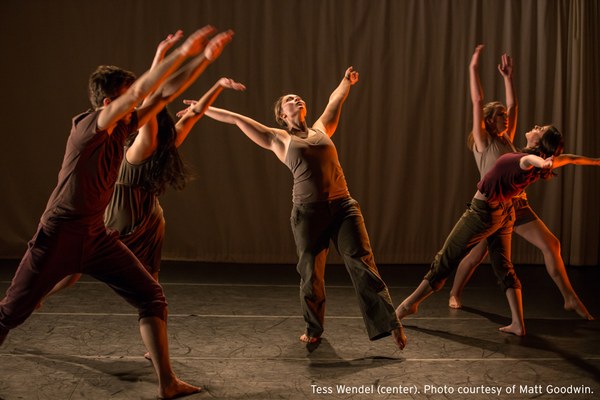
The coordination and balance it takes to dance helped Tess in her recovery, along with professional physical therapy. Climbing has a lot of the same physical strengthening components as dance, but with less spinning.
Tess enrolled in Basic Climbing in the winter of 2013, and was placed in a mentor group with leader Jim Pitts. She still had regular headaches, her balance and strength wasn’t as strong as it could be, and she was temporarily prone to vertigo — particularly when climbing on snow on a cloudy day with flat light. It was a struggle, especially the conditioning. Less than a year prior, it was an accomplishment for Tess to walk around the block. Now she was attempting to climb mountains. Tess was terrified of not keeping up. “You know how they tell you after surgery not to lift heavy things?” she said. “There’s a reason.”
It was type-two fun from the very beginning, but that didn’t hold her back. Tess comes from the self-proclaimed fear-of-missing-out (FOMO) generation. Her first two basic climbs were Unicorn and Castle Peak, followed by Mount Baker and South Early Winter Spire.
Encouraged by her early success and mentors, Tess began lead climbing. It was a whole new game. She found herself asking, “Why am I here? Why am I doing this? Am I having fun? I’m not sure I’m having fun.” But climbing gave her confidence, focus, and a community of encouraging people.
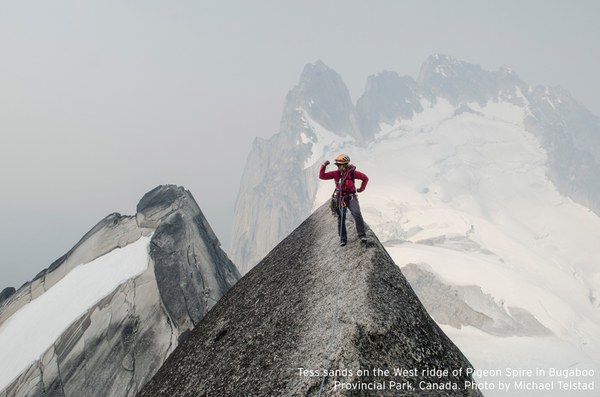
Dedicated Mountain Time
By 2014, Tess had graduated Basic Climbing and was accepted into the Intermediate Climbing course. She was part of Stef Schiller’s all women’s climbing group. Stef was on a personal mission to increase women leadership in climbing and Tess was happy to jump on the sharp end.
Tess became an official climb leader after two years of Intermediate, and ran Seattle’s new Intro to Multi-pitch class in 2017. She is continuing her work with Seattle climbing to modularize the Intermediate Climbing program — basically splitting up the longer course into several specific (and less time-consuming) classes that add together to create requirements for the Intermediate Climbing course.
Climbing really became part of her identity. Tess watched the weather every Friday but was frustrated with short weekend opportunities. “If you’re going to be working on your lead head,” Tess said, “you need to be leading rock regularly.” So she started thinking about how to get dedicated time in the mountains. By the summer of 2017, she had been working at The Mountaineers for five years and had coworkers who could cover for her, so was able to take a nearly two-month climbing sabbatical from early July to late August, split into two parts.
The first part was spent on an ice field in Canada. Tess, along with her boyfriend, Michael Telstad, and climbing partners, Mark Schaeffer and Hadi Al-Saadoon, drove two days from Seattle to a heli-port base in White Saddle near the town of Tatla Lake in the Western Chilcotin Region of British Columbia. They then took a helicopter ride to the Ha-Iltzuk Icefield — the largest icefield in the Coast Mountains south of the Alaska Panhandle — where they were dropped off for a week. It was such a vast landscape of ice, Tess said, “flying overhead, you wouldn’t know the glaciers are melting.”
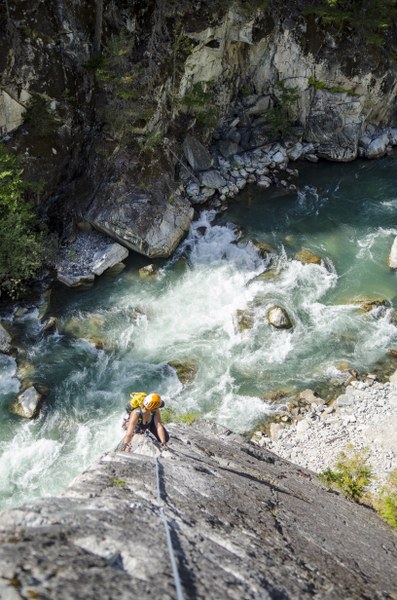
Recalibrating Plans
There’s an unwritten rule in nature that when a person spends a lot of money to get somewhere, the weather isn’t going to cooperate. It rained nearly the whole week. Tess, Michael, Mark, and Hadi spent a lot of time at base camp and going for afternoon glacier walks to nearby saddles while enjoying the moody landscape. Their original goal was Mount Silverthrone, rumored to be British Columbia’s tallest volcano, but there were no weather windows long enough. Even if there had been, the snow was too waterlogged to hold an ice ax or picket — which also meant that snow bridges were weak. They made the best of their time with games of Frisbee, preparing gourmet camp food (fried butter bagels), and even watching Star Wars on a smartphone while listening to the rain from inside their tents.
Tess returned to the office for a week, then headed out again to complete her climbing sabbatical, but not before taking a quick weekend canyoneering trip with her coworker, Becca Polglase. After eight successful waterfall rappels, Tess slipped and fell walking the last 100 feet of the creek during the “least technical part of the day.” Tess sliced her hand open and had to get five stitches. Climbing was off the table for now.
Tess and Michael headed to Glacier National Park in Montana, where they ran into Matthew Palubinskas and Katy Snyder, who shared tips on where to go. From Montana, Tess and Michael headed back to Canada — this time to Banff National Park. They visited the Columbia Icefield and Lake Louise, known for its turquoise waters, then went on to neighboring Jasper National Park, where they scrambled Cinquefoil peak, hiked below Edith Cavell, and went swimming in Annette and Edith Lakes.
By this time, Tess’s hand was feeling better and she was able to spend the next six days climbing in the Bugaboos with Michael. They climbed three different routes on Crescent Towers: Lions Way (5.6), Ears Between (5.8/5.9), and Eeyore (5.9), along with the so-called “best 5.4 in the world” — the west ridge of Pigeon Spire. Tess learned more about her comfort level with steep snow and ice there than she did on the remote icefield.
They ended their trip in Squamish, just north of Vancouver, climbing the Chief via its three ultra classic routes - Ultimate Everything (5.10-), Squamish Buttress (5.10c), and Angels Crest (5.10b). They also sent other classic sport climbing routes at Smoke Bluffs and Cheakamus Canyon. Not bad for dedicated mountain time.
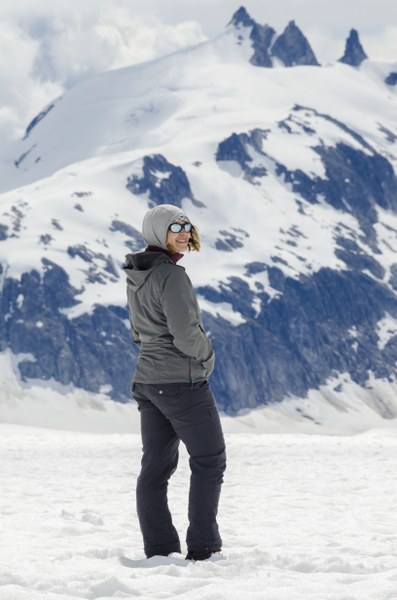
Presence and Patience
Tess’s favorite part about climbing is that she’s constantly learning. Every trip has a new lesson to teach, whether it’s about gear, route-finding, self-care, or perseverance. Having brain surgery also taught her a lot about patience. It forced her off the path she was on and made her focus on the present. “With all surgeries or big life events,” Tess says, “you learn to look at what’s in front of you. Priorities become clearer.”
Tess used to be worried she wouldn’t be able to keep up — but not so much anymore. Besides, she says, “I know the mountains will always be there — probably with fewer glaciers. But the rocks aren’t going anywhere.”
After nearly six years, Tess is moving on from The Mountaineers. Read more about her next adventures here.
 Suzanne Gerber
Suzanne Gerber